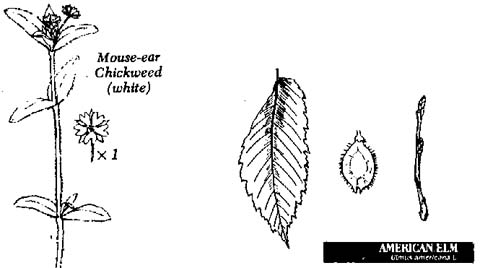
| code | probability of wetland occurrence | |
| OBL | Obligated wetland species | 99% |
| FACW | Facultative Wetland species | 67-99% |
| FAC | Facultative species | 34-66% |
| FACU | Facultative upland species | 1-33% |
| UPL | Upland species | 1% |
Sometimes called swamp ash, this medium sized tree reaches 40-50'
in cool swamps, wet woods, and bottomlands throughout Pennsylvania. Wood
ducks, game birds and songbirds and many mammals eat the seeds. Whitetaled
deer browse the twigs and young foliage.
Source: Dix, Edward, T.; Common Trees of Pennsylvania;
Department of Conservation & Natural Resources, P. 21
White Avens Geum canadense
FACU, Native species
Basal leaves with 1 or 3 large, terminal leaflets and several small
leaflets along the stalk. White flowers 1/2" wide, the petals as long or
longer than the sepals. Stem smooth to slightly hairy. 1 - 2 1/2' high.
Thickets and open woods. Summer, sometimes fall.
Source: Newcomb, Lawrence; Newcomb's Wildflower Guide;
Little, Brown and Company; New York 1977 p. 232
Blackberries Rubus allegheniensis
FACU, Native species
Stems prickly. White flowers about 1" wide with the petals longer than
the sepals. Flowers in racemes. Fruit juicy, black. Divided by botanists
into numerous species. 2 - 8' high. Dry fields, clearings.
Source: Newcomb, Lawrence; Newcomb's Wildflower Guide;
Little, Brown and Company; New York 1977 p. 232
Gather sweet, juicy black fruit in late July or August. Eat raw.
Source: Elias, Thomas S. & Dykeman, Peter A.; Edible
Wild Plants; Sterling Publishing Co., Inc.; New York 1990 p. 183
American Bladdernut Staphylea trifolia
FAC, Native Species
Bladdernut Family
Drooping racemes of white flowers; leaflets finely toothed. Petals
erect. Fruit an inflated, 3-pointed pod, 2-3" long. Bark striped. 4-15'
high. Habitat: Moist thickets and banks. Spring.
Source: Newcomb, Lawrence, Newcomb's Wildflower Guide,
Little, Brown and Company.
Common Burdock Arctium minus
Introduced species
Catalpa Catalpa speciosa
FAC, Introduced species
Leaves: Opposite or whorled, simple heart-shaped, 6-10" long and 6"
wide, smooth above and hairy beneath. Bark: light brown, shallowly ridged
and scaly. A short-trunked, broad-crowned tree, to 49'. Native to southern
states, but now widely planted and frequently escaped in the Eastern U.S.
Source: Dix, Edward, T.; Common Trees of Pennsylvania;
Department of Conservation & Natural Resources, P. 13
Mouse-eared Chickweed Cerastium vulgatum
FACU, Introduced species
Petals about as long as the sepals; flowers about 1/4" wide. Stem hairy.
Leaves oblong, 1/2 - 1" long. Common weed of gardens, lawns and roadsides.
Spring to fall.
Source: Newcomb, Lawrence; NewcombÕs Wildflower
Guide; Little, Brown and Company; New York 1977 p. 274

Chokecherry Prunus virginiana
FACU, Native species
Petals roundish; white flowers in dense racemes, the racemes 1 1/2
- 4" long. Leaves egg-shaped, short-pointed, finely and sharply toothed.
The flowers resemble those of the Black Cherry (P. serotina), a tree with
bluntly toothed leaves. Fruit dark red to purplish, acid. 2 - 20' high.
Thickets and borders. Spring. Rose family.
Source: Newcomb, Lawrence; Newcomb's Wildflower Guide;
Little, Brown and Company; New York 1977 p. 314
Pick fruit from mid-summer to October. Can be used as a trail
thirst-quencher or to make jelly. Do not eat pits of seeds.
Source: Elias, Thomas S. & Dykeman, Peter A.; Edible
Wild Plants; Sterling Publishing Co., Inc.; New York 1990 p. 204
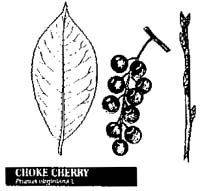
Cleavers Galium aparine
FACU, Native species
Leaves 1 - 3" long; flowers 1 - 3 in a cluster, growing from the axils;
fruit bristly. A sprawling, prickly plant of woods, thickets and shores.
Late spring and early summer.
Source: Newcomb, Lawrence; Newcomb's Wildflower Guide;
Little, Brown and Company; New York 1977 p. 152
Pick young greens in spring when tender. Steam for five to ten
minutes. Gather fruits in June and July as they turn brown. Use ground,
roasted roots as a coffee substitute.
Source: Elias, Thomas S. & Dykeman, Peter A.; Edible
Wild Plants; Sterling Publishing Co., Inc.; New York 1990 p. 86
Oxeye Daisy Chrysanthemum leucanthemum
Introduced species
Asiatic Dayflower Commelina communis
FAC, Introduced species
Spiderwort Family
Description: Blue flowers, 1/2-1" wide, with 2 large blue petals above
and 1 very small white petal below, growing singly or in small clusters.
Leaves lance-shaped and tapering. The similar Virginia Dayflower has 3
blue petals. Weak-stemmed plant, 6-15" long, rooting at the joints. Moist,
shaded places, often around dwellings. Summer and fall.
Source: Newcomb, Lawrence, Newcomb's Wildflower Guide,
Little, Brown and Company.
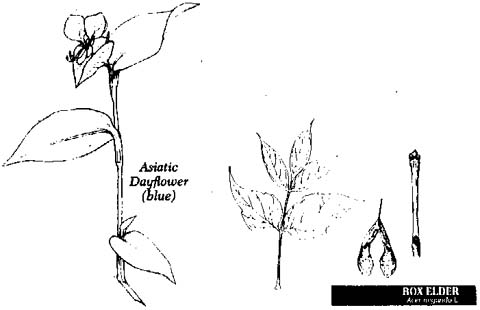
Box Elder Acer negundo
FAC+, Native species
The pinnate leaves of Box Elder may be yellow, bronze or brown, but
are never red. Each leaf has 3-7 elliptic or ovate, serrate leaflets 1-2"
long. Pendant stalks bearing paired flat, light brown "keys" or fruits
remain on the twigs through the fall and help in identification of Box
Elder. This fast growing, often weedy tree is found in lowland forest and
along forest margins, along roadsides, and in waste places. Although the
leaves of mature trees are usually a drab tan or greenish gray in autumn,
the yellow leaves of stump sprouts can be quite attractive.
Source: Bell, Ritchie C. and Lindsey, Anne H., Fall
Color and Woodland Harvest, Laurel Hill Press.
American Elm Ulmus americana
FACW-, Native species
Leaves: Simple, alternate, 4" - 6" long, unequal at the base, rather
rough on the upper surface; usually soft-hairy bellow; veins prominent;
margin coarsely toothed. Leaf-stem short. Twigs: Slender, zigzag, brown,
smooth or slightly hairy. Leaf buds 1/8" - 1/4" long, flattened. Flower
buds larger, below leaf buds. Bud scales red-brown, smooth or downy; margin
dark. Fruit: A seed surrounded by an oval, thin papery wing, 1/2" long,
deeply notched at the tip; ripening in spring and bone in clusters; wing
with scattered hairs along margin. Flowers and fruit appear before the
leaves, as is true of slippery elm. General: Bark dark gray to gray-brown,
with long corky ridges; on older trees separated by diamonds-shaped fissures.
A large and highly prized shade tree. The dropping crown often gives it
a vase-shaped appearance. Found locally throughout Pennsylvania, mainly
on moist areas. The hard, tough wood has many uses, including the manufacture
of boxes, barrels and furniture.
Source: Common Trees of Pennsylvania, Department
of Forests and Waters. p. 37
Philadelphia Fleabane Erigeron philadelphicus
FACU, Native species
Description: Flower heads 1/2-1" wide, pinkish or whitish, with 100-150
rays; upper leaves clasp the stem. Soft-hairy. 6-30" high. Habitat: Open
woods and fields. Spring and summer.
Source: Newcomb, Lawrence, Newcomb's Wildflower Guide,
Little, Brown and Company. p. 382
Field Garlic Allium vineale
FACU-, Introduced species
Purplish or greenish flowers in an umbel; leaves very narrow, hollow.
Flowers often replaced by bulblets. 1 - 3' high. Serious pest of lawns,
pastures and meadows. Mass. to Mich. south. Summer. Lily Family.
Source: Newcomb, Lawrence; Newcomb's Wildflower Guide;
Little, Brown and Company; New York 1977 p. 348
Poison Hemlock Conium maculatum
FACW, Introduced species
Coarse plant of waste places (occasionally riverbanks) with a smooth,
spotted stem; bracts beneath umbel entire. Base of leaves enlarged and
sheathing the stem. Deadly poisonous if eaten. 2-6' high. Late spring and
summer. Parsley family.
Source: Newcomb, Lawrence; Newcomb's Wildflower Guide;
Little, Brown and Company; New York 1977 p. 220
All parts of the plant are poisonous. The toxic alkaloids cause
nervousness, trembling, reduced heart rate, coma, and even respiratory
failure.
Source: Elias, Thomas S. & Dykeman, Peter A.; Edible
Wild Plants; Sterling Publishing Co., Inc.; New York 1990 p. 268
Honeysuckle Family Caprifoliaceae sp.
Mostly shrubs, sometimes vines or herbs, commonly with showy flowers.
Flowers: radically or bilaterally symmetrical, usually in a branched or
forked cluster; sepals 5 small; corolla with 5 petals united into a slender
tube, flared into a trumpet-shaped end of forming an upper and lower lip;
stamens usually 5. All these parts attached at the top of ovary. Leaves:
opposite, simple or compound. Fruit: berry, drupe, or capsule. There are
about 15 genera and 400 species in north temperate regions and in tropical
mountains. Snowberries, honeysuckle and elderberries are grown as ornamental,
and elderberries are also eaten or made into jelly or wine.
Source: The Audubon Society Field Guide to North American
Wildflowers.
Ground Ivy Glechoma hederaceaea
FACU, Introduced species
Blue or violet flowers, 1/3 - 1/2" long; stem creeping at the base.
Leaves long-stalked, bluntly toothed. A common weed of moist waste places.
Spring and early summer. Mint Family.
Source: Newcomb, Lawrence; Newcomb's Wildflower Guide;
Little, Brown and Company; New York 1977 p. 86
Japanese Knotweed Polygonum cuspidatum
FACU-, Introduced species
Description: Large, bushy plant, 4-10' high, with broad, short-pointed
leaves. The greenish-white flowers grow in branching spikes, mostly from
axils. Escaped from cultivation to waste places and roadsides.
Source: Newcomb, Lawrence, NewcombÕs Wildflower
Guide, Little, Brown and Company.
Black Locust Robinia pseudoacacia
FACU-, Native species
Type of plant: Tree-hardwood. Size: Medium, intolerant to shade. Origin:
Native. Major uses: Site improvement (nurse tree with hardwood), wildlife
food and cover, fenceposts, fuel, watershed protection. Comments: Most
frequently and widely used tree for surface-mine planting; adapted to a
wide range of minesoil types. Established easily by direct seeding and
planted seedlings. Provides quick overstory cover due to rapid growth.
Surviving healthy trees can be cut for fenceposts. Locust seed is prime
quail food in some areas. Use as a "nurse" tree is controversial. Locust
improves a site for growth of other trees, especially for natural invasion
of hardwoods; but its thorny branches can physically damage leaders and
bark of smaller, slower growing adjacent trees. Locust should make up no
more than 25 to 33 percent of a planted hardwood mix.
Source: Willis G. Vogel, U.S. Department of Agriculture,
Forest Service, A manual for training reclamation inspectors in the
fundamentals of soils and revegetation.
Honey Locust Gleditsia triacanthos
FAC-, Native species
Leaves: Alternate, once and twice compound, 7-8" long, having even
numbers of 1" long leaflets with fine toothed margins. Bark: Greenish brown
with many long raised, horizontal lines of lenticels on younger trees,
becoming brown to nearly black with long, narrow, scaly ridges separated
by deep fissures and often covered with clusters of large branched thorns.
Medium sized, 40-50' but can reach 140' high. Found naturally on rich,
moist bottomlands in southwestern PA. Many animals feed on the pods and
the seedlings.
Source: Dix, Edward, T.; Common Trees of Pennsylvania;
Department of Conservation & Natural Resources, P. 54
Silver Maple Acer saccharinum
FACW, Native species
Leaves: Opposite, simple, deeply, 5-lobed and coarsely toothed, about
5" wide, bright green above, silvery-white beneath. Fall color is greenish-yellow.
Bark: Smooth and gray on young trunks, older trunks brown and furrowed
with plates that curl out on the ends. Found in moist woods and on stream
banks throughout PA usually reaching 50-60' high. Many mammals and birds
eat the seeds.
Source: Dix, Edward, T.; Common Trees of Pennsylvania;
Department of Conservation & Natural Resources, P. 16
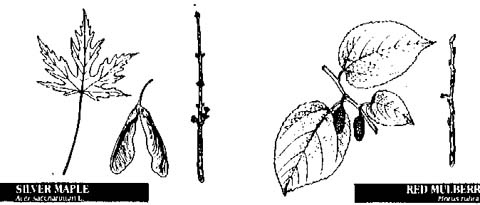
Red mulberry Morus rubra FACU, Native species
The yellow leaves of Red Mulberry are 2-8" long, about the same size
as those of White Mulberry, but not as glossy and more sharply pointed.
Although this small tree is native to our hardwood forests, it has been
spread widely by birds to fencerows, clearings and roadsides over much
of the eastern United States. The sweet, juicy fruits are eaten by man,
beasts, and birds, and the wood can be used for fence posts and furniture.
The inner bark of young shoots was used by some Indians to make crude cloth.
Source: Bell, Ritchie C. and Lindsey, Anne H., Fall
Color and Woodland Harvest, Laurel Hill Press.
Moth Mullein Verbascum blattaria
Introduced species
Garlic Mustard Alliaria officinalis
FACU-, Introduced species
Leaves coarsely toothed, long-stalked. White flowers, 1/4 - 1/3" wide.
Leaves smell of garlic when crushed. 1 - 3' high. Roadsides and open woods.
Spring and early summer. Mustard Family.
Source: Newcomb, Lawrence; Newcomb's Wildflower Guide;
Little, Brown and Company; New York 1977 p. 138
Chop tender young leaves, blossoms, and seed pods for salads or
steam in a little water for cooked vegetable.
Source: Elias, Thomas S. & Dykeman, Peter A.; Edible
Wild Plants; Sterling Publishing Co., Inc.; New York 1990 p. 85
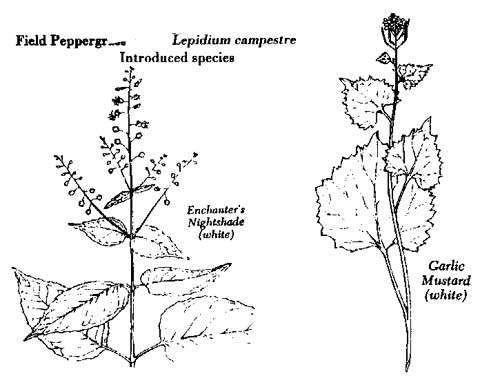
Enchanter's Nightshade Circaea quadrisulcata
FACU, Native species
Small, white flowers in short racemes. Petals deeply 2-lobed. Leaves
egg-shaped and long-stalked, opposite. Leaves shallowly toothed, 2-4" long.
Plant 1-2' high. Wood and thickets. Summer. Evening Primrose Family.
Source: Newcomb, Lawrence; Newcomb's Wildflower Guide;
Little, Brown and Company; New York 1977 p. 116
Everlasting Pea Lathyrus latifolius
Introduced species
Field Peppergrass Lepidium campestre
Introduced species
Pokeweed Phytolacca americana
FACU+, Native species
Pokeweed Family (Phytolacaceae)
Description: A tall, large-leaved, branching plant with reddish stems
and long clusters of small, white flowers. Flowers: about 1/4" wide; sepals
5, white petal-like; petals absent. Leaves: 5-12" long, elliptic-lanceolate,
tapering at both ends. Fruit: dark purple-black berry, 1/4" wide, in drooping
clusters. Height: to 10'. Flowering: July-September. Habitat: Open woods,
damp thickets, clearings, roadsides. Range: Ontario to southern Quebec,
New England, and New York; south to Florida; west to Texas and Mexico;
north to Minnesota. Comments: This is frequently a troublesome weed with
poisonous berries and roots, although emerging shoots can be gathered before
the pink color appears, cooked, and eaten as greens. The berry juice was
used as a dye by the early colonists and to improve cheap wine.
Source: The Audubon Society Field Guide to North American
Wildflowers.
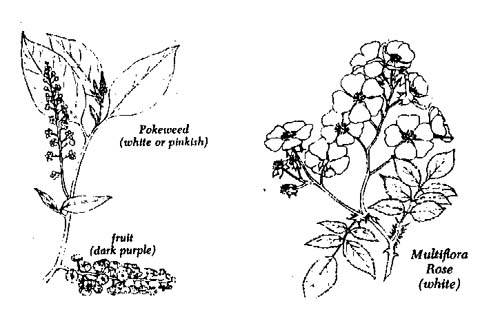
Black Raspberries Rubus occidentalis
Native species
Bouncing Bet; Soapwort Saponaria officinalis
FACU-, Introduced species
Pink Family (Caryophyllaceae)
Description: Leafy, sparingly branched plant with smooth stems, swollen
at the nodes and terminal clusters of white or pinkish fragrant flowers.
Flowers: about 1" wide, with 5 delicate, scalloped petals with small appendages
at their throats; occasionally double of with extra petals; calyx 5-lobed,
the tube often splitting in double-flowered forms. Leaves: 2-3" long, opposite,
oval, with 3-5 conspicuous veins. Height: 1-2 1/2'. Flowering: July-September.
Habitat: Roadsides and disturbed areas. Range: Throughout. Comments: This
attractive, phlox-like perennial, introduced from Europe, spreads by underground
stems and forms sizable colonies. The plant contains poisonous saponins
(soap-like substances) that inspired the genus mane (from Latin sapo, meaning
"soap") and the alternate common name Soapwort. Lather can be made from
its crushed foliage. The common name, Bouncing Bet, is an old-fashion nickname
for a washerwoman.
Source: The Audubon Society Field Guide to North American
Wildflowers.
Staghorn Sumac Rhus typhina
Native species
Sycamore Platanus occidentalis
FACW-, Native species
The pale gray to bright white bark of the upper trunk and spreading
limbs of Sycamore stands out along the courses of streams and the edges
of moist floodplains on the brown winter landscape, more than making up
for the usual sedate brown tones of the treeÕs autumn foliage. The
broad, 3 - lobed, sharply serrate leaves are usually 4 - 8" long and wide.
The base of the trunk of these trees may be up to 3' or more in diameter;
a historic Sycamore along the Ohio River had a reported circumference of
47'. The bark on the lower trunk is dark gray and rough. These large, widespread
trees are important source of timber. In Colonial times, the cores of the
round fruits, along with the tough fruit stalk and a short piece of the
twig, were used for buttons.
Source: C. Ritchie Bell, Anne H. Lindsey, Fall Color
and Woodland Harvests.
Pale Touch-me-not ; Jewelweeds Impatiens pallida
FACW, Native species
Yellow flowers about 1" long, dangling from a long stalk. The flowers
have a short inward-curved spur at the back. The leaves are egg-shaped,
coarsely toothed. Fruit a plump pod that explodes when ripe. Stem succulent,
2 - 5' high. Moist places. Summer and early fall. Boil young shoots for
a potherb for 10-15 minutes. The seeds separated form the rest of the fruit
can be eaten raw. When applied to the skin the juice can prevent and relieve
the symptoms of Poison Ivy, Nettles, and fungal dermatitis. The anti-fungal
agent is 2-methoxy-1, 4-naphthoquinone.
Source: Newcomb, Lawrence, Newcomb's Wildflower Guide,
Little, Brown and Company.
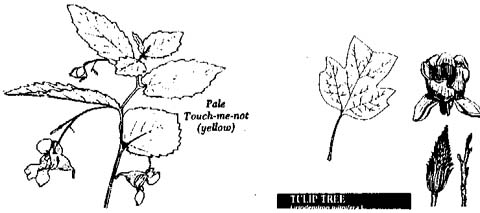
Tuliptree Liriodendron tulipfera
FACU, Native species
Leaves: Simple, alternate, 4' - 6' in diameter, generally 4-lobed,
bright green, turning yellow in autumn. Twigs: In spring and summer, green,
sometimes with purplish tinge; during winter reddish brown, smooth, shiny.
Buds large, smooth flattened, "duck-billed." Fruit: At first green, turning
light brown when ripe in autumn; cone-like, 2.5" - 3" long, made up of
winged seeds. Greenish yellow tulip-like flowers in may or June. general:
Bark at first dark green and smooth; whitish vertical streaks soon appearing;
later dark gray and furrowed. A large tree, the tallest of the eastern
hardwoods. It grows rapidly and is an important timber and shade tree.
The wood is valuable for veneer and many other uses. Also known as tulip
poplar.
Source: Common Trees of Pennsylvania, Department
of Forests and Waters.
Crown Vetch Coronilla varia
Introduced species
Black Willow Salix nigra
FACW+, Native species
Leaves: Simple, alternate, long and narrow, short-stemmed, sharp pointed,
fine teeth on the margin, average length 3"; dark green above, much lighter
below. The stipples ("small leaves" at the base of leaf-stems of the main
leaves) remain through most of the summer. Twigs: Slender, brittle at the
base, bright reddish brown to orange - green. Buds covered by a single
scale, small, cone-shaped, sharp-pointed. Fruit: Small brown capsule, 1/4"
long, borne in long hanging clusters; ripens in May or June. Each tiny
seed surrounded by tufts of long silky hair. General: Bark thick, dark
brown, separating into broad, flat plates or ridges as the tree grows older.
A small to medium-sized tree. Only native willow which grows to a fair
size. Found mainly in moist situations. Often several trunks arise from
the same root system.
Source: Common Trees of Pennsylvania, Department
of Forests and Waters. p. 51
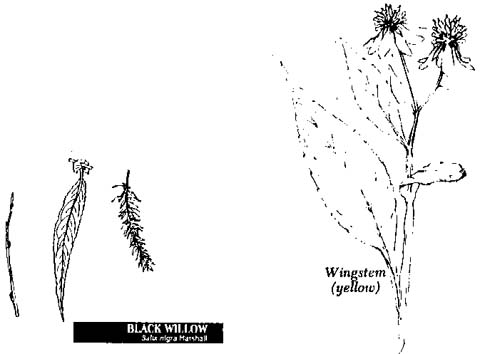
Wingstem Actinomeris alternifolia FAC, Native species
Composite Family
Flowers ray 10 or less, drooping, widest in middle; upper part of stem
usually winged (with thin ridges running down the stem below the leaves).
Flower heads 1-2" wide, with an untidy, moplike disk. Leaves lance-shaped
or oblong, the lower leaves sometimes opposite. 3-8' high. Habitat: Rich
soil. Late summer and fall.
Source: Newcomb, Lawrence, Newcomb's Wildflower Guide,
Little, Brown and Company; New York; 1977
Bell, Ritchie C. and Lindsey, Anne H., Fall Color and Woodland Harvest, Laurel Hill Press.
Common Trees of Pennsylvania, Department of Conservation & Natural Resources, Bureau of Forestry
Elias, Thomas S. & Dykeman, Peter A.; Edible Wild Plants; Sterling Publishing Co., Inc.; New York 1990
Firehock, Karen & Doherty, Jaqueline; A CitizenÕs Streambank Reclamation Handbook; Save Our Streams Program, Izaak Walton League of America, Inc.; Gaithersburg, MD, 1995
Newcomb, Lawrence, Newcomb's Wildflower Guide, Little, Brown and Company; New York; 1977
Willis G. Vogel, U.S. Department of Agriculture, Forest Service,
A manual for training reclamation inspectors in the fundamentals of
soils and revegetation.